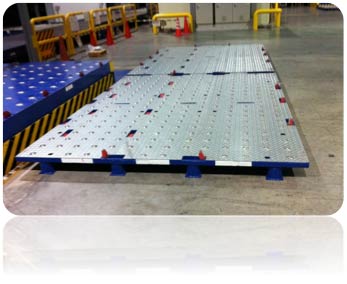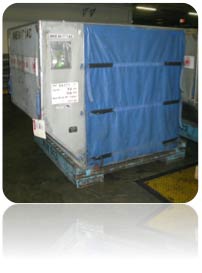Cargo Terminals, Freight Forwarders, CARE, Storage
Slave Pallets: A Low Cost Solution for ULD Storage and Handling
In this article we look at slave pallets as a practical and economical solution to handling ULDs, without causing damage.
The 3rd ULD CARE newsletter contained an article on the storage of ULDs. Continuing with this theme, in this article we look at slave pallets as a practical and economical solution to handling ULDs, without causing damage.

Slave Pallets are devices that allow fork-lift trucks to lift-and-carry ULDs while properly supporting the base of the container. The top of the slave pallet has rollers that permit the ULD container to be transferred as needed.

A slave pallet is essentially a dolly without wheels with provision for fork lifts tines. Often manufactured by the same companies that manufacture dollies, a slave pallet is not that expensive nor are they difficult to use. Enter “ULD Slave Pallet” into a Google search and a good number of suppliers come up offering various sizes and designs, to suit ULDs from the smallest to the largest base sizes.
Turning the clock back many years, early containers were very often equipped with forkliftable bases. This design equipped them for use in “bare bones” warehouse situations where ULDs were placed directly on the floor. Today, with a few exceptions, ULDs are hardly ever fitted with forklift bases. The simple reasons are that they add considerable weight and reduce useable volume. In addition to reducing the effective payload of the container, they also cost more. On top of this, the growth in air cargo volumes has driven the number of pallets in use to many times higher than in the ‘70’s and ‘80’s.
A container fitted with a forkliftable base is very capable of being handled, empty or loaded, with little more than a forklift. However, this is not true for pallets nor for single base containers. As the industry has slowly but steadily moved away from forkliftable base containers, the facilities and practices employed in the air cargo industry have not adapted.
The design of the vast majority of ULDs in use today requires that they be supported on a transfer surface such as rollers or ball mats during storage or movement. The design of these systems, which are not dissimilar to the design of the cargo loading system on aircraft, is defined in the IATA Airport Handling Manual (AHM 611). AHM 611 is conveniently reproduced in Appendix C of the IATA ULD Regulations. Setting aside the possibility of the occasional accident, ULDs, when handled this way, will not suffer any damage during the ground processes.
The IATA ULD Regulations (Section 9.3 Appendix A “ Guidelines for Forklift Drivers”) make it clear that “ULDs must at all times be handled and stored with care and attention to achieve zero damage” and that “Forklifting a ULD without extreme care will most certainly result in costly damage and result in the ULD becoming unserviceable”. Nobody is saying that the forklift shall be eliminated from the ULD operations environment, but what is absolutely clear is that there is a responsibility on the party carrying out ULD handling to do so without damage to the units. This is where slave pallets can play a major role.
 The IATA ULD Regulations are very clear, so why do we not see more of these pieces of damage reducing equipment in use? The answer probably lies somewhere between a lack of awareness of their existence through to an unwillingness to make even the relatively small expenditure necessary to equip a facility.
The IATA ULD Regulations are very clear, so why do we not see more of these pieces of damage reducing equipment in use? The answer probably lies somewhere between a lack of awareness of their existence through to an unwillingness to make even the relatively small expenditure necessary to equip a facility.
One can hope that this article addresses the lack of awareness issue by not only reaching all our readers, but also providing our readers with this self-contained article which can be passed on to other colleagues who need to be informed.
With regard to the cost of implementing the use of slave pallets, it must be said that the proper storage and handling of ULDs is a cost of doing business. Any organization whose business activity involves handling ULDs and that is not able to set up a highly mechanized ULD storage and transfer facility, will find the use of slave pallets a very practical solution.
Somehow over time, many sectors of the air cargo industry have become accustomed to following unsatisfactory practices and procedures in the handling and storage of ULDs. In an accompanying article in this ULD CARE newsletter, is an article on the costs associated with buying and maintaining ULDs. These are effectively costs borne, almost always, by the airline. This is clearly not a sustainable situation. Airlines cannot keep spending 100’s of millions of dollars each year on ULD damage that is often caused by improper ground handling. The widespread application of slave pallets in air cargo operations would be a giant step in the right direction.


